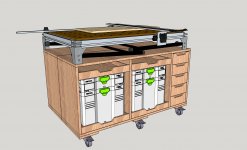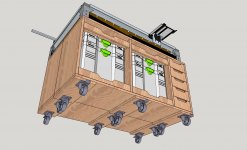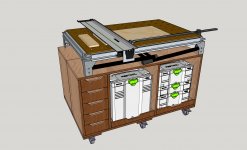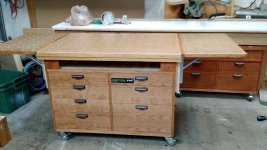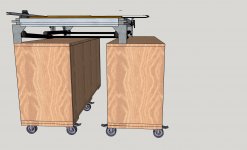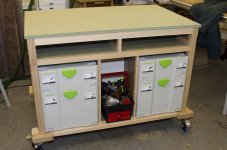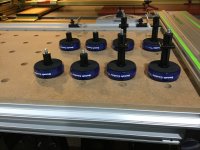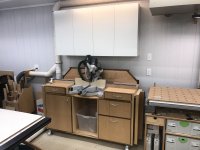Bugsysiegals
Member
- Joined
- Mar 19, 2016
- Messages
- 909
Hello everyone, I'm building some shop cabinets and need your advice on a few points.
The cabinets will store my Festool systainers and support my MFT table allowing it to be used as an out-feed table for my Table Saw, Jointer, Planer, Band Saw, etc.
I’ll be using 3/4" plywood w/Maple veneer for the carcass (1 side is prefinished and I’ll be edge banding), Rockler 3” total-lock swivel casters, and I’ve not decided yet on drawers (probably ½” sides and bottoms) or drawer slides/glides (probably full extension slides with quickscrews).
The cabinets will be supporting about 100 lbs. of Festool systainers, 60 lb. MFT table, and whatever wood I’m cutting. To ensure it can support this weight adequately, how should I proceed with the following …
1) Joinery – I considered using rabbits (top/bottom) and dado’s (dividers) but figured this would weaken the cabinets weight capacity and domino’s would be better for this reason, do you agree?
2) Caster Support – I’ve seen mobile cabinet builds which use an extra layer of plywood between the cabinet base and casters, does this provide extra strength or is this unnecessary?
3) Casters – Would you add casters to the center of the cabinet for additional support and to prevent sag or is this unnecessary?
I’ve attached a few rough draft photos for reference. FYI - I was originally considering face frames with Walnut contrast but opted to go frameless for more drawer space and not sure I like the Brown contrast any longer, thoughts?
The cabinets will store my Festool systainers and support my MFT table allowing it to be used as an out-feed table for my Table Saw, Jointer, Planer, Band Saw, etc.
I’ll be using 3/4" plywood w/Maple veneer for the carcass (1 side is prefinished and I’ll be edge banding), Rockler 3” total-lock swivel casters, and I’ve not decided yet on drawers (probably ½” sides and bottoms) or drawer slides/glides (probably full extension slides with quickscrews).
The cabinets will be supporting about 100 lbs. of Festool systainers, 60 lb. MFT table, and whatever wood I’m cutting. To ensure it can support this weight adequately, how should I proceed with the following …
1) Joinery – I considered using rabbits (top/bottom) and dado’s (dividers) but figured this would weaken the cabinets weight capacity and domino’s would be better for this reason, do you agree?
2) Caster Support – I’ve seen mobile cabinet builds which use an extra layer of plywood between the cabinet base and casters, does this provide extra strength or is this unnecessary?
3) Casters – Would you add casters to the center of the cabinet for additional support and to prevent sag or is this unnecessary?
I’ve attached a few rough draft photos for reference. FYI - I was originally considering face frames with Walnut contrast but opted to go frameless for more drawer space and not sure I like the Brown contrast any longer, thoughts?

